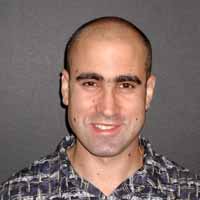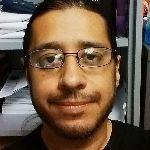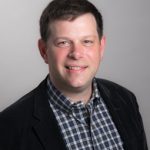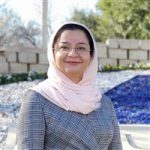Apr 05, 2019
Near-optimal Smooth Path Planning for Multisection Continuum Arms
Iyad Kanj – DePaul University
Abstract: Continuum arms, such as trunk and tentacle robots, attempt to mimic the biological appendages—like elephant trunks—and have seen a surge of research in recent years. These robots lie between the two extremities of rigid and soft robots and promise to capture the “best” of both worlds in terms of manipulability/elasticity, degrees of freedom, and compliance. Their need spans industrial, manufacturing, and healthcare applications, in which safe human-robot collaboration is essential. Despite their demonstrated capabilities in manipulability, superior performance in constrained spaces, and compliant operation, their full potential has not been realized yet. This lag is primarily due to their inherent physical features, which, while making continuum arms human-friendly, contribute to complexities in path planning and control. In this talk, we present how to leverage the continuum arm features to introduce a new graph-theoretic based planning approach for multisection arms to achieve deterministic, reliable, and smooth path planning. The graph algorithm proposed facilitates us to exploit parallelism in the computation to obtain efficient implementation. The results show the completeness of the proposed algorithm successfully finds path amidst multiple obstacles when such a path exists, and otherwise, reports that no path exists.

Speaker Bio: Iyad Kanj’s research interests include parameterized complexity, graph theory and algorithms, combinatorial optimization, computational geometry, and bioinformatics.
Apr 12, 2019
Enhancing Efficiency and Security of Mobile Cyber-Physical Systems
Wenwen Wang – University of Minnesota
Abstract: We are in an exciting era of mobile computing. Our everyday life is benefiting from the advancement of mobile technologies. However, mobile computing faces some fundamental challenges, such as constrained computing capacity, limited battery life, and poor security support. How to improve the performance of mobile applications with limited computing resources, as well as prolonging the battery life and enhancing security, are some of the critical issues facing mobile computing today. In this talk, I will present my recent research that leverages system virtualization and program analyses to address these issues. First, I will describe a mobile computation offloading system powered by cross-architecture virtualization, which can offload computation-intensive tasks from mobile devices to more powerful remote servers that usually have a different computer architecture. A significant advantage of this offloading system, compared to previous systems, is that it enables offloading for extensive mobile applications, including native binaries, across different platforms, e.g., ARM vs. x86. Next, to enhance the security of mobile computing, I will introduce a static program analysis approach to automatically detect security vulnerabilities in operating system kernels. After applying this approach to the latest Linux kernel, which is widely used in mobile cyber-physical systems, many previously unknown security vulnerabilities are uncovered and confirmed, and most of these vulnerabilities have been fixed with our provided patches.
Speaker Bio: Wenwen Wang is a postdoctoral researcher in the Department of Computer Science and Engineering at the University of Minnesota, Twin Cities. He received his Ph.D. from the University of Chinese Academy of Sciences. His research interests span a wide spectrum of key issues that cut across computer architectures, compilers, runtimes, operating systems, mobile computing, and system security. His recent research effort has been focused on the performance, scalability, and energy efficiency issues in system virtualization and improving the security and privacy of critical hardware and software systems. His research has led to a series of publications in competitive conferences that include ASPLOS, USENIX ATC, MobiSys, CCS, ASE, and VEE. His overall research goal is to address the question of how to build efficient, secure, and reliable computer systems in an era in which computing has become ubiquitous in our everyday life.
Apr 26, 2019
Title: The Quest for Meaning: Challenges in Studying Satisfaction with Telemedicine
Robert Garcia – DePaul University
Abstract: Telemedicine adoption by medical institutions continues to rise. As the market grows there is an increased number of telemedicine products and services for organizations to evaluate. Among the criteria that is typically used to evaluate the success of telemedicine is stakeholder satisfaction. However evaluations of stakeholder satisfaction with telemedicine are often criticized for their lack of rigor, generalizability, and questions remain about the actual meaning of satisfaction with telemedicine.
 Speaker Bio: Robert Garcia is a Ph.D. candidate at the DePaul University College of Computing and Digital Media. Robert has worked as a manager and researcher in the DePaul Innovation-Development Lab (iD-Lab) where he has led teams in successful R&D projects for fortune 500 companies. He has taught courses in programming, web development and computing for various colleges and nonprofit organizations. His research focuses on human interaction and perceptions of systems including Telemedicine and Augmented Reality. His current research centers around investigating factors that contribute to satisfaction with telemedicine systems. His work includes writings in the Journal of Medical Systems, the Hawaii International Conference on System Sciences and in Global Health and Volunteering Beyond Borders: A Guide for Healthcare, among others.
Speaker Bio: Robert Garcia is a Ph.D. candidate at the DePaul University College of Computing and Digital Media. Robert has worked as a manager and researcher in the DePaul Innovation-Development Lab (iD-Lab) where he has led teams in successful R&D projects for fortune 500 companies. He has taught courses in programming, web development and computing for various colleges and nonprofit organizations. His research focuses on human interaction and perceptions of systems including Telemedicine and Augmented Reality. His current research centers around investigating factors that contribute to satisfaction with telemedicine systems. His work includes writings in the Journal of Medical Systems, the Hawaii International Conference on System Sciences and in Global Health and Volunteering Beyond Borders: A Guide for Healthcare, among others.
May 03, 2019
Title: Watching Atoms Move
Eric Landahl – DePaul University
Abstract: Improvements in computer processor speed, solar electricity generation, Light Emitting Diodes, solid-state refrigeration, flash memory, and high-speed internet are examples of technology developments that depend upon ongoing research into materials called semiconductors. I will describe how it is now possible to measure and manipulate the fundamental interactions of heat, sound, light, and electrons in these materials by making high-speed atomic-resolution movies. I will discuss some of the surprising behaviors that we have observed, the challenges these findings present to emerging technologies, and some of the spin-offs that are resulting from this research.
 Speaker Bio: Eric Landahl received his BA in Physics from the University of Chicago, his MS in Physics from DePaul University, and his Ph.D. in Engineering and Applied Science from the University of California, Davis. He worked at Lawrence Livermore National Laboratory, the Stanford Linear Accelerator Center, and Argonne National Laboratory before returning to the DePaul University Physics Department.
Speaker Bio: Eric Landahl received his BA in Physics from the University of Chicago, his MS in Physics from DePaul University, and his Ph.D. in Engineering and Applied Science from the University of California, Davis. He worked at Lawrence Livermore National Laboratory, the Stanford Linear Accelerator Center, and Argonne National Laboratory before returning to the DePaul University Physics Department.
May 10, 2019
Title: Array of Things: Evaluating a network of low-cost air quality sensors
Mark Potosnak – DePaul University
Abstract: The Array of Things (AoT) is a collaborative effort among leading scientists, universities, local government, and communities in Chicago to collect real-time data on the city’s environment, infrastructure, and activity for research and public use. The AoT is an urban-scale “instrument” that will enable the City, urban planners, residents, and researchers to monitor and examine Chicago’s environment, infrastructure and activity, including detecting trends and changes over time. Ultimately, the goal is to measure the city in sufficient detail to provide data to help engineers, scientists, policymakers and residents work together to make Chicago and other cities healthier, more livable and more efficient. A key component of an AoT node is the air quality board (ChemSense) with surface chemistry sensors that measure carbon monoxide, hydrogen sulphide, nitrogen dioxide, ozone and sulfur dioxide. These measurements will link human activities (for example, traffic counts) with human health and are therefore critical for achieving the AoT goal. But low-cost sensors have many limitations compared to instruments that use Federal Reference Methods (RFM) to measure air pollutants. Ultimately, the AoT air quality data will be assessed holistically, but the first step is to compare AoT results to FRM measurements.
The chemical sensors are calibrated by the manufacturer and shipped for installation in the AOT module. To test the performance of these sensors after placing them in an AOT node, a collocation experiment was designed. We are currently conducting this study to evaluate the performance of these low-cost gas sensors with reference grade systems operated by the EPA. The collocation site is operated by Cook County on behalf of the US EPA for air quality standards conformance in the county. There are three gases measured by Chemsense that are also monitored by the EPA instruments: ozone, NO2 and SO2. The SO2 levels measured at the site are relatively low and often below the detection limit of the Chemsense SO2 sensor. As a result, we have focused our attention on understanding ozone and NO2. There is considerable cross sensitivity between the ozone and NO2 sensors. Three types of error were considered: random, systematic and spikes for evaluation with the reference instruments. For NO2 and ozone, the random error is larger than the reference sensor, but the results are encouraging (r2 > 0.65). There was some systematic error in the zero (residual from Chemsense compared to EPA data) that might be related to either sensor drift or temperature, but the level was relatively low and should be amenable to analysis with spatial techniques across the Array. We are continuing the analysis of spikes in the NO2 signal that were not detected by the EPA reference sensor and were not related to temperature or absolute humidity. Overall, the results are very encouraging and demonstrate that the Chemsense boards produce data that can be applied to city-wide urban air quality science questions.
 Speaker Bio: Associate professor and chair of Environmental Science & Studies at DePaul University, Dr. Mark Potosnak has degrees from Harvard and Columbia Universities, and he was a fellow in the Advanced Study Program at the National Center for Atmospheric Research. His research focuses on interactions between the plants and air quality. Specifically, he studies how trace gas emissions from plants affect atmospheric chemistry and how climate change will impact this interaction in the future. His field studies have been conducted in temperate, tropical, urban, arid and tundra ecosystems. Dr. Potosnak also deploys low-cost air quality sensors to engage citizen scientists and to explore how spatial patterns of air quality within Chicago are related to socioeconomic drivers.
Speaker Bio: Associate professor and chair of Environmental Science & Studies at DePaul University, Dr. Mark Potosnak has degrees from Harvard and Columbia Universities, and he was a fellow in the Advanced Study Program at the National Center for Atmospheric Research. His research focuses on interactions between the plants and air quality. Specifically, he studies how trace gas emissions from plants affect atmospheric chemistry and how climate change will impact this interaction in the future. His field studies have been conducted in temperate, tropical, urban, arid and tundra ecosystems. Dr. Potosnak also deploys low-cost air quality sensors to engage citizen scientists and to explore how spatial patterns of air quality within Chicago are related to socioeconomic drivers.
May 17, 2019
Title: The Untapped Potential of Database Forensics
Abstract: Data in our everyday lives (e.g., banking data, cell phone contents) is stored in relational database management systems (DBMS). DBMSes provide a standard interface (e.g., SQL) to the users, while opaquely managing storage and query execution. Therefore, users must implicitly trust that their database is acting as desired and that the database has not been compromised in any way. In cases of suspected fraud, tampering, or data theft, a forensic investigation and audit is performed; however, a pronounced lack of database forensic tools makes investigating a DBMS particularly challenging.
In this talk, we will review the basics of database forensic analysis and several applications including detection of data tampering and data theft perpetrated by extra-privileged users. We will also describe the concept of a meta-querying that can be used to reliably collect evidence from DBMS storage or to erase data contents to ensure user privacy.
 Speaker Bio: Dr. Alexander Rasin is an Associate Professor in the College of Computing and Digital Media (CDM) at DePaul University. He received his Ph.D. and M.Sc. in Computer Science from Brown University, Providence. He is a co-Director of Data Systems and Optimization Lab at CDM and his primary research interest is in database forensics and cybersecurity applications of forensic analysis. Dr. Rasin’s other research projects focus on building and tuning the performance of domain-specific data management systems — currently in the areas of computer-aided diagnosis and software analytics. Several of his research projects are supported by NSF.
Speaker Bio: Dr. Alexander Rasin is an Associate Professor in the College of Computing and Digital Media (CDM) at DePaul University. He received his Ph.D. and M.Sc. in Computer Science from Brown University, Providence. He is a co-Director of Data Systems and Optimization Lab at CDM and his primary research interest is in database forensics and cybersecurity applications of forensic analysis. Dr. Rasin’s other research projects focus on building and tuning the performance of domain-specific data management systems — currently in the areas of computer-aided diagnosis and software analytics. Several of his research projects are supported by NSF.
May 24, 2019
Title: How to Continuously Improve Information Security Management Practice
Fereshteh Ghahramani – DePaul University
Abstract: In information-intensive organizations secured management of information has become an important issue. Although organizations have been actively investing in information security, the crime rate in this area keeps increasing. Practitioners and academics have started to realize that information security cannot be achieved through only technological tools. Effective organizational information security depends on how to manage such activities in organizations.
Empirical research on the management side of information security behaviors and factors influencing them is still in its infancy. The aim of this talk is to focus on continuous improvement of information security management practices in organizations and uncover factors that play a significant role in this continuous improvement using organizational learning perspective.
 Speaker Bio: Dr. Fereshteh Ghahramani is an Assistant Professor in the College of Computing and Digital Media (CDM) at DePaul University. She received her Ph.D. in Management Information Systems from the University of Texas at Arlington. Her primary research interests include behavioral information security and healthcare IT.
Speaker Bio: Dr. Fereshteh Ghahramani is an Assistant Professor in the College of Computing and Digital Media (CDM) at DePaul University. She received her Ph.D. in Management Information Systems from the University of Texas at Arlington. Her primary research interests include behavioral information security and healthcare IT.
May 31, 2019
Title: Transparency: Past/Present/Future
Heather Quinn – DePaul University
Abstract: “Transparency: Past/Present/Future” is a body of work that uses design fiction to explore the boundaries of privacy through methods of creative obfuscation. These stories showcase the breadth of human ingenuity for primal need and desire, often against much larger powers—embracing the idea that innovation and unsettling systems—can be done by anyone.
Throughout history, humans have always necessitated methods for hiding their secrets and maintaining their privacy. Their methods of concealment, however, have evolved with time and available technologies. Despite more advanced technologies and even the utmost diligence, no secret is ever totally safe—unless kept in the depths of one’s mind. However, a speculated near future indicates that not even our thoughts are secure: we are on the cusp of the invasion of the privacy of our minds and the possible altering of our memories.
In the past, we obfuscated physically with materials—primarily using cryptography and steganography—through redaction, the wearing of masks, and the hiding of physical objects. In the present, we obfuscate digitally with false personas, filters, altered data, and encrypted messaging. In the future, I use design fiction to speculate that we will be internally surveilled—to the very root of our DNA. As a result, we will obfuscate our bodies—our physical and emotional states.
Analysis of our methods of secrecy within the silos of past, present, and future, allows for a deeper understanding of our evolving human boundaries. In the present day, we struggle to understand technologies power on the fabric of our lives. If we look ahead 100 years, what are the ethical considerations of emerging technologies? If we imagine the collapse of democracy and a future society lived in a panoptic spectacle, how would we navigate our lives?
 Speaker Bio: Heather Snyder-Quinn, MFA an educator, designer, and writer. She teaches at DePaul University’s School of Design, and previously taught at Rhode Island School of Design. Heather has worked as an experience designer for over 23 years at agencies including, SapientRazorfish, Fitch and Essential Design, and opened her design practice in 2001 creating work for clients including MIT, IBM, Harvard, The United Nations, Forrester Research and OpenPediatrics. Her creative and pedagogical work uses design fiction as a method to engage with radical technologies, including augmented reality, artificial intelligence, and IoT. Heather’s work has been presented and exhibited nationally and internationally most recently at SIGCHI, UCDA, CAA, AIGA, RISD, Design Incubation, TDC and internationally at Design Principles in Barcelona and The Frans Masereel Centre in Belgium. This September she received a Society of Typographic Arts 100 award for her experimental publication “Lost in Translation” which utilizes GoogleTranslate’s augmented reality feature. Currently, she is co-chair of AIGA Chicago’s Women Lead Initiative and Speculative Futures Chicago.
Speaker Bio: Heather Snyder-Quinn, MFA an educator, designer, and writer. She teaches at DePaul University’s School of Design, and previously taught at Rhode Island School of Design. Heather has worked as an experience designer for over 23 years at agencies including, SapientRazorfish, Fitch and Essential Design, and opened her design practice in 2001 creating work for clients including MIT, IBM, Harvard, The United Nations, Forrester Research and OpenPediatrics. Her creative and pedagogical work uses design fiction as a method to engage with radical technologies, including augmented reality, artificial intelligence, and IoT. Heather’s work has been presented and exhibited nationally and internationally most recently at SIGCHI, UCDA, CAA, AIGA, RISD, Design Incubation, TDC and internationally at Design Principles in Barcelona and The Frans Masereel Centre in Belgium. This September she received a Society of Typographic Arts 100 award for her experimental publication “Lost in Translation” which utilizes GoogleTranslate’s augmented reality feature. Currently, she is co-chair of AIGA Chicago’s Women Lead Initiative and Speculative Futures Chicago.
Jun 07, 2019
Title: Wearable technologies for restoring mobility in individuals with disabilities
Chandrasekaran Jayaraman – Shirley Ryan AbilityLab
Abstract: Advances in wearable technology capabilities are leading to restoring of lost mobility functions in individuals with disabilities. The spectrum of wearable technologies available spans from assistive technologies, like passive (like walkers) and active (powered) robotic technologies, to activity monitor (wearable sensors). The advent of such miniature wearable sensors and the correct implementation of them for clinically relevant assessment is providing novel insights into the dynamics of interaction between the human, the machine (assistive technology) and/or the intervention. Such insights are equipping us with enhanced ability to evaluate wearable technologies, customize user-machine parametrization and in turn optimize the design (product or process) for improving health outcomes. Through this talk, I will share some of our recent cutting edge clinical research implementing wearable technologies for better health outcomes.
The first half of this talk will focus on my research regarding guidelines for validating and correct implementation of wearable sensor technologies for measuring health outcomes in individuals with mobility impairment. Following this, I will share some preliminary results from my ongoing research where we practice this implementation to evaluate/custom tune a novel powered knee-ankle prosthetic device for a unilateral transfemoral amputee. I will wrap this talk with sharing some findings from ongoing research studies with wearable sensors by my colleagues at the Center for Bionic Medicine at the Shirley Ryan Ability Lab, Chicago.
 Speaker Bio: Dr. Jayaraman’s research blends approaches from biomechanics, human motor control, occupational ergonomics, and assistive technology to identify markers that impacts the quality of life of individuals with limited physical ability. His current investigation focuses on comparing the biomechanical performance and effectiveness of different transfemoral prosthetic devices. The goal is to bridge the findings between biomechanical outcomes and policy requirements to inform technology transfer. He is also concurrently investigating the choice of optimal biomechanical parameters for manual standing wheelchair propulsion to minimize shoulder injury. Dr. Jayaraman’s previous research mainly focused on overuse injury to shoulder in manual wheelchair users. His innovative approach used a multi-disciplinary paradigm integrating approaches from upper extremity biomechanics, human motor control, occupational ergonomics, and nonlinear dynamics to identify biomarkers that related to overuse injuries to shoulders in manual wheelchair users.
Speaker Bio: Dr. Jayaraman’s research blends approaches from biomechanics, human motor control, occupational ergonomics, and assistive technology to identify markers that impacts the quality of life of individuals with limited physical ability. His current investigation focuses on comparing the biomechanical performance and effectiveness of different transfemoral prosthetic devices. The goal is to bridge the findings between biomechanical outcomes and policy requirements to inform technology transfer. He is also concurrently investigating the choice of optimal biomechanical parameters for manual standing wheelchair propulsion to minimize shoulder injury. Dr. Jayaraman’s previous research mainly focused on overuse injury to shoulder in manual wheelchair users. His innovative approach used a multi-disciplinary paradigm integrating approaches from upper extremity biomechanics, human motor control, occupational ergonomics, and nonlinear dynamics to identify biomarkers that related to overuse injuries to shoulders in manual wheelchair users.
